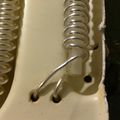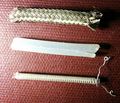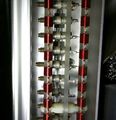Delay line: Difference between revisions
No edit summary |
|||
| (40 intermediate revisions by 8 users not shown) | |||
| Line 1: | Line 1: | ||
Delay lines in oscilloscopes allow observation | |||
of the leading edge of the trigger event. In the vertical signal path, | |||
before the delay line, there is typically a trigger pick-off | |||
which supplies an undelayed copy of the vertical signal to the trigger | |||
and sweep circuitry. Trigger and sweep circuitry need about 60ns to react | |||
when presented with the trigger event. Without a delay line, the trigger event | |||
would already have come and gone before the scope can trigger and sweep. By sending | |||
the input signal through a delay line, the scope will have triggered and begun sweeping | |||
by the time the trigger event emerges from the delay line. Thus, the trigger event | |||
is drawn on the screen where the operator can see, photograph, or record it | |||
by other means. | |||
The first Tektronix scope to contain a delay line was the [[513|513D]], which uses an L-C network. | The first Tektronix scope to contain a delay line was the [[513|513D]], which uses an L-C network. | ||
Soon after, the [[517]] appeared, using | Soon after, the [[517]] appeared, using 51 feet of RG-63U coaxial cable as a 65 nanosecond delay line. | ||
7000-series scopes use special twin-lead delay cables. The delay line in the [[519]] is a large | [[Introduction_to_the_7000-Series_Oscilloscopes|7000-series]] scopes use special twin-lead delay cables and have a plug-in option, the [[7M11]]. The delay line in the [[519]] is a large | ||
coil of low-loss air-dielectric semi-rigid coax. | coil of low-loss air-dielectric semi-rigid coax. | ||
The location of the delay line in the instrument block diagram varies: | |||
* Delay before any active electronics: [[4S1]], [[1S1]] | |||
* Delay between amplifiers: [[517]], [[7000 series scopes]], [[315]], [[547]], [[524]] | |||
are | * Delay between amplifier and CRT: [[516]], [[533]], [[545]], [[551]], [[555]] | ||
and | |||
__TOC__ | |||
==Types of Delay Lines== | |||
There are five main ways delay lines are implemented | |||
in Tektronix scopes | |||
===Conventional coaxial cable=== | |||
Used in [[517]], [[4S1]], [[3S76]], [[1S1]] and [[DL-11]]. | |||
<gallery> | |||
File:Tek_3s76_left.jpg|Coaxial cable delay line in a 3S76 | |||
</gallery> | |||
===Semi-rigid air-core coax=== | |||
Used in [[519]], [[113]] | |||
<gallery> | |||
File:Timkoeth_519_TWK_6537.jpg|Delay line in a 519. | |||
</gallery> | |||
===Unshielded helically wound differential transmission line=== | |||
Used in [[581]], [[585]] | |||
<gallery> | |||
File:585a_delay1.jpg|Section of a [[585|585A]] delay line. Two conductors are wound around a plastic core, one conductor clockwise, the other counterclockwise. | |||
</gallery> | |||
===Helically wound differential transmission line inside braided shield=== | |||
Used in [[545|545B]], [[547]] | |||
<gallery> | |||
File:Tek rm545b delay.jpg|Section of a [[545|RM545B]] Delay Line. From outside to inside: Outer Braid, Plastic, Conductors, Plastic Core | |||
</gallery> | |||
===Lumped L-C=== | |||
Lumped L-C delay lines are used in the [[511|511AD]], [[513|513D]], [[514|514D]], [[531]]/[[533]]/[[535]], [[541]]/[[543]]/[[545]], [[551]], [[555]], and [[524]]. | |||
These delay lines must be carefully adjusted for best pulse response. | |||
A typical lumped L-C delay line has about 30 sections, and each section typically has an adjustable capacitor. | |||
In some applications, lumped L-C delay lines were preferred over distributed delays (e.g., coax) because of impedance. | |||
It is possible for a lumped L-C delay line to have a characteristic impedance of 1000 Ω, while most coaxial cables are 125 Ω or less. | |||
The high impedance made it possible to run the line straight to the CRT deflection plates and absorb the reflected wave at the amplifier. This was called reverse termination, and it doubled amplifier gain while simplifying amplifier construction. It was first applied to Type [[535]], at serial number 8628. (101-8627 ran the lumped line between two amplifier chassis with termination on each end, as the [[585]] and [[547]] did with helically-wound line later.) | |||
<gallery> | |||
Tek_514d_delay_trimmers.jpg|Delay line trimmer capacitors in a [[514D]]. | |||
551_leftint.jpg|Delay line in a [[551]] wraps around the rear left side of the scope. | |||
Tek 545a delay close.jpg|Section of delay line of [[545A]]. Trimmer capacitors can be seen behind the inductor. | |||
Tek 533a delay line 1.jpg | |||
Tek 533a delay line 2.jpg | |||
Tek 535a delay line 1.jpg | |||
Tek 535a delay line 2.jpg | |||
</gallery> | |||
==Delay Lines in Sampling Oscilloscopes== | |||
The purpose of delay lines in sampling scopes is | |||
the same as for conventional non-sampling scopes. | |||
Since sampling scopes are often used for observing fast pulses, | |||
delay lines are often problematic since they have dispersion, | |||
and therefore distort pulse waveforms. | |||
For example, the [[4S1]] contains a delay network | |||
while the [[4S2]] does not. Because of this, | |||
the 4S2 is a less convenient instrument, | |||
but has faster rise-time than the 4S1. | |||
One way around the trade-off between pulse response and convenience | |||
is to use [[random sampling]]. | |||
Delay | ==See Also== | ||
* [[:Category:Delay_lines|External Delay Lines]] | |||
* [[Patent US 2756394]] | |||
* [[Patent US 2854640]] | |||
* [[Patent US 4729510]] | |||
* [[Media:Rosenheim anderson vhf pulse.pdf|VHF Pulse Techniques and Logical Circuitry]] | |||
* [[Media:Electronics letters apr 1970.pdf|Use of High-Relative-Permittivity Materials in High-delay Coaxial Lines]] | |||
* [[Media:Wigington nahman.pdf|Transient Analysis of Coaxial Cables Considering Skin Effect]] | |||
[[Category:Electromechanical components]] | |||
[[Category:Circuits and Concepts]] | |||
Latest revision as of 11:13, 22 December 2023
Delay lines in oscilloscopes allow observation of the leading edge of the trigger event. In the vertical signal path, before the delay line, there is typically a trigger pick-off which supplies an undelayed copy of the vertical signal to the trigger and sweep circuitry. Trigger and sweep circuitry need about 60ns to react when presented with the trigger event. Without a delay line, the trigger event would already have come and gone before the scope can trigger and sweep. By sending the input signal through a delay line, the scope will have triggered and begun sweeping by the time the trigger event emerges from the delay line. Thus, the trigger event is drawn on the screen where the operator can see, photograph, or record it by other means.
The first Tektronix scope to contain a delay line was the 513D, which uses an L-C network. Soon after, the 517 appeared, using 51 feet of RG-63U coaxial cable as a 65 nanosecond delay line. 7000-series scopes use special twin-lead delay cables and have a plug-in option, the 7M11. The delay line in the 519 is a large coil of low-loss air-dielectric semi-rigid coax.
The location of the delay line in the instrument block diagram varies:
- Delay before any active electronics: 4S1, 1S1
- Delay between amplifiers: 517, 7000 series scopes, 315, 547, 524
- Delay between amplifier and CRT: 516, 533, 545, 551, 555
Types of Delay Lines
There are five main ways delay lines are implemented in Tektronix scopes
Conventional coaxial cable
Used in 517, 4S1, 3S76, 1S1 and DL-11.
-
Coaxial cable delay line in a 3S76
Semi-rigid air-core coax
-
Delay line in a 519.
Unshielded helically wound differential transmission line
-
Section of a 585A delay line. Two conductors are wound around a plastic core, one conductor clockwise, the other counterclockwise.
Helically wound differential transmission line inside braided shield
-
Section of a RM545B Delay Line. From outside to inside: Outer Braid, Plastic, Conductors, Plastic Core
Lumped L-C
Lumped L-C delay lines are used in the 511AD, 513D, 514D, 531/533/535, 541/543/545, 551, 555, and 524. These delay lines must be carefully adjusted for best pulse response. A typical lumped L-C delay line has about 30 sections, and each section typically has an adjustable capacitor. In some applications, lumped L-C delay lines were preferred over distributed delays (e.g., coax) because of impedance. It is possible for a lumped L-C delay line to have a characteristic impedance of 1000 Ω, while most coaxial cables are 125 Ω or less. The high impedance made it possible to run the line straight to the CRT deflection plates and absorb the reflected wave at the amplifier. This was called reverse termination, and it doubled amplifier gain while simplifying amplifier construction. It was first applied to Type 535, at serial number 8628. (101-8627 ran the lumped line between two amplifier chassis with termination on each end, as the 585 and 547 did with helically-wound line later.)
-
Delay line trimmer capacitors in a 514D.
-
Delay line in a 551 wraps around the rear left side of the scope.
-
Section of delay line of 545A. Trimmer capacitors can be seen behind the inductor.
-
-
-
-
Delay Lines in Sampling Oscilloscopes
The purpose of delay lines in sampling scopes is the same as for conventional non-sampling scopes. Since sampling scopes are often used for observing fast pulses, delay lines are often problematic since they have dispersion, and therefore distort pulse waveforms. For example, the 4S1 contains a delay network while the 4S2 does not. Because of this, the 4S2 is a less convenient instrument, but has faster rise-time than the 4S1. One way around the trade-off between pulse response and convenience is to use random sampling.










